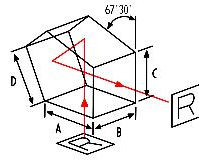The penta prism is a five-sided prism with two important characteristics: First, it deflects light by 90 degrees without rotating the image or causing mirror reflection. Second, it is a fixed-angle deflection device, meaning all incident light is turned by exactly 90 degrees. This makes pentaprisms essential components in rangefinders and also useful in single-lens reflex (SLR) cameras. The reflective surfaces of the prism are coated with aluminum (Al) and protected with a black lacquer.
Total Internal Reflection: When light enters one of the right-angle faces of the prism, it undergoes total internal reflection on the hypotenuse face and then exits through the other right-angle face, achieving a 90-degree deflection. This property makes right-angle prisms widely used in optical systems for altering and adjusting light paths.
Variety of Materials: Right-angle prisms can be made from different materials depending on specific application requirements, such as UV fused silica, H-K9L, calcium fluoride, and zinc selenide. These materials have distinct optical and physical properties, making them suitable for different wavelength ranges and working environments.
High Transmittance and Low Absorption: Certain materials like calcium fluoride and zinc selenide offer high transmittance over a wide wavelength range, making them ideal for high-precision optical systems. Zinc selenide also has low absorption, making it suitable for applications in both the infrared and visible light ranges.

Specifications | Commercial spec. | High precision spec. |
Material | UV glass (Quartz, Fused silica) VIS glass (Schott, CDGM, HOYA, etc.) IR material: (Sapphire, ZnSe, Silicon, etc.) Special material: (SiC) | |
Dimension | 5mm~350mm | |
Dimension tolerance | ±0.1mm | ±0.05mm |
Surface quality | 60/40 | 40/20 |
Surface flatness | 1/4λ | 1/10λ |
Clear aperture | >85% of dim | >90% of dim |
Angle tolerance | 3 arc min | 5 arc sec. |
Bevel | <0.2mm x 45deg | <0.1mm x 45deg |
Coating | Up on clients’ request | |
Type No. | Dimension | Clear aperture |
PP-10 | 10.0mm *10.0mm*10.0mm | 7.0mm*7.0mm*7.0mm |
PP-20 | 20.0mm*20.0mm*20.0mm | 14.0mm*14.0mm*14.0mm |
PP-40 | 40.0mm*40.0mm*40.0mm | 28.0mm*28.0mm*28.0mm |
PP-60 | 60.0mm*60.0mm*60.0mm | 42.0mm*42.0mm*42.0mm |
Spectral Analysis: In spectroscopic instruments, right-angle prisms are used to decompose composite light into its spectrum. Equilateral prisms are commonly used for this purpose. Newton demonstrated the dispersion of white light into a colorful spectrum using a triangular prism, proving that white light is composed of multiple colors.
Optical Instruments: In devices like periscopes and binoculars, right-angle prisms change the direction of light to adjust the imaging position. These prisms typically have a right-angle design to make more efficient use of space.
Beam Control and Deviation: In applications requiring precise control of the light path, right-angle prisms can achieve beam deviation and reflection. They are suitable for fields such as optical communication, laser technology, and precision measurement.
